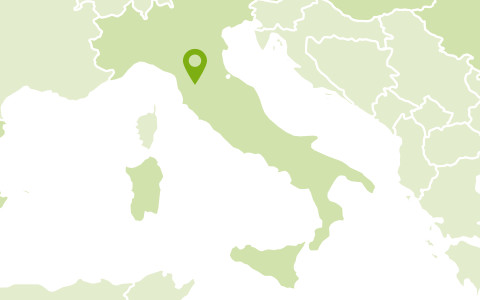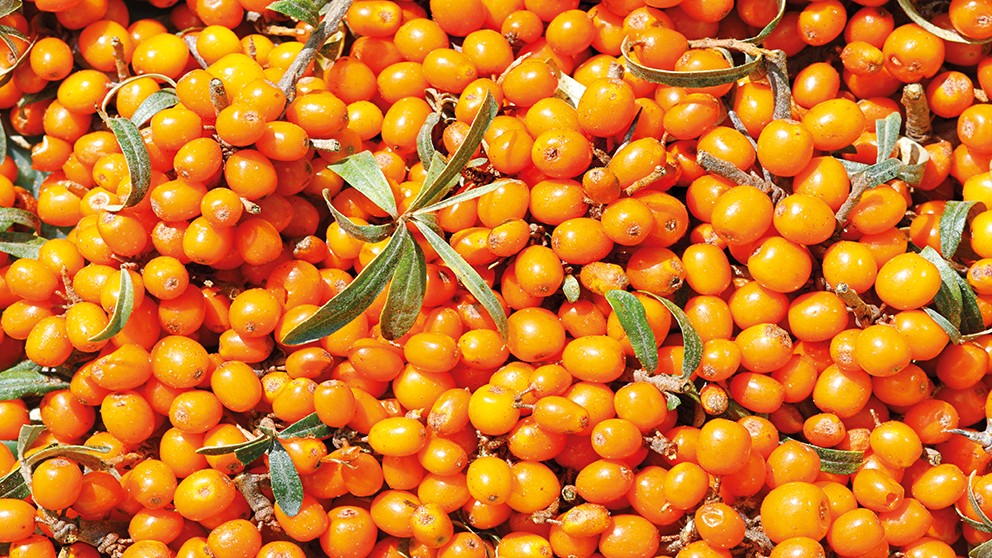Sea Buckthorn
Tuscany, Italy

Vitamin C-packed berries, bursting with sunshine
Sea buckthorn is originally a wild plant from Central Asia. Over millennia it spread naturally across from the Alps in central Europe to the coasts of the North and Baltic Seas. The ripe berries of the sea buckthorn have provided vitamin-packed juice for Weleda’s supplements for almost 70 years. During the Second World War, when scientists were looking for natural sources of vitamin C, they came across sea buckthorn in Switzerland and decided to harness the plant’s potential. This was the birth of products known today as Sea Buckthorn Juice and Elixir). More recently, Weleda developed rich natural and organic cosmetic products based on sea buckthorn oils.
Finest varieties thriving
For the last two decades, the berries have been sourced from wild plants found in controlled areas of the Alps. Today the finest sea buckthorn varieties are found thriving in an area of about 100 hectares in San Mario, bringing an annual harvest of 200 tonnes of fresh, organically grown berries. The Künzi & Röthlisberger family business presses almost 100 tonnes of fresh juice from these, in a close partnership with Weleda which has lasted for over ten years.
Kurt Künzi, a traditional plant breeder, began to experiment with cultivating selected sea buckthorn varieties from the Alps in the late 1980s. Selection and breeding of the most suitable varieties is a complex process, which takes time and patience. Breeders increase the amount of plants taking cuttings of small branches from selected parent plants, grown in a special soil-compost mixture.
Kurt eventually moved his biodynamic farming operation to San Mario in the Pisan Maremma, in Tuscany near the sun-soaked city of Pisa. The growing conditions here are ideal – the soil is nourished with compost and the hours of sunshine are longer even than they are in the southern Alpine valleys. This is important because sea buckthorn needs as much light as it can get to build its valuable vitamin complexes. But still it’s only after three to four years that analysis reveals whether the berries’ juice delivers good enough composition and quality.

Kurt Künzi and his team are currently cultivating more than five varieties of sea buckthorn. For juice and syrups, to be taken internally, there are varieties that have a rich content of vitamins and trace elements. And as with wine, attention must be paid to the aroma, acidity and the correct mixture of different varieties in the juice. Other varieties are better at producing nutrient-rich sea buckthorn oil for cosmetic products, because they have a higher oil content in the fruit’s flesh, like olives, and are therefore valuable to restorative skin care.
For Kurt Künzi and his four employees, sustainability permeates everything they do in San Mario. It begins with the selection of plants, continues in the biodynamic fields and includes the use of energy-saving processes, smart compost management and herbal and mineral preparations to promote soil vitality. Thus, the plants remain healthy and are not prone to pests and diseases. The management at San Mario matches the ecological criteria that Weleda chooses too. With our own in-house cultivation of medicinal plants Weleda uses this method, which is almost as old as the company itself.
Harvesting takes place on the fields by cutting the branches manually – for the berries grow close to the sea buckthorn branches this is the most effective way. For the rest a specially-designed threshing apparatus, the ‘sea buckthorn chameleon’ strips the berries from the branches. Then they go into cold storage, labelled by variety, and are pressed into juice for Weleda in small batches. The juice is gently pasteurised and packed into airtight containers, while a further process step collects the sea buckthorn seed and juice oils.

